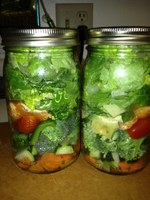Prairie Fare: Bring on the Leafy Greens This Winter
(Click the image below to view a high-resolution image that can be downloaded)
By Julie Garden-Robinson, Food and Nutrition Specialist
NDSU Extension Service
Our snow accumulation in North Dakota has been meager this winter. Looking out my window, I can see spots of dormant, brownish grass. I’m not complaining.
At this time of winter, I begin wishing for spring and the sign of green vegetation. I do not have a warm-weather-destination trip planned, so I probably won’t see grass for a few months.
I decided we should add more leafy greens to our wintry comfort-food-filled menu. My menus tend to have more cooked vegetables than fresh ones.
On the bright side, fresh, frozen and canned vegetables are nutritious, and they all count toward the adult goal of 2 cups per day. I just need some “fresh vegetation” now and then.
I was inspired while shopping at a warehouse-type store to buy a fairly large plastic bin of mixed leafy greens. The spinach, romaine and other leafy greens were welcome additions to my plate.
When I stacked my plate with greens for a couple of meals, I didn’t seem to be making a “dent” in the container. My family had a “standard” side dish of mixed greens until we ate the entire container of salad.
Leafy greens are among the “nutritional powerhouse foods” in our diet. Dark green vegetables include spinach, romaine, collards, turnip, mustard greens and broccoli. Unfortunately, many people do not eat enough dark green vegetables, so current recommendations set a specific goal for leafy greens.
The 2010 Dietary Guidelines for Americans recommends that we have at least 1 1/2 cups of dark green vegetables per week.
Why the emphasis on dark green vegetables? These low-calorie foods contain natural pigments that are converted to vitamin A, which plays a role in maintaining the health of our skin and eyes.
Some pigments in leafy greens, namely lutein and zeaxanthin, play a role in maintaining our eye health. When you have spinach, kale and broccoli, you literally are “feeding your eyes.”
Leafy greens are among the best sources of vitamin K, which is important for blood clotting, heart health and bone health.
People on certain blood-thinning medications are advised to keep a consistent intake of leafy greens so the drug does not interact with the vitamin. Be sure to follow the guidance from your health-care provider.
If you are a Pinterest fan, you may have seen pictures of “salads in a jar.” If you are inspired and a little crafty, try this layering technique to make a main-dish salad that you can transport to work or eat at home. Be sure to leave enough room in the jar for plenty of leafy greens.
- Add 2 tablespoons of your favorite salad dressing to the bottom of a quart-sized mason jar.
- Add a layer of “hard” vegetables, such as sliced carrots, cucumbers, radishes and chopped broccoli. These vegetables protect the layers from getting soggy.
- Add cooked beans or brown rice.
- Add protein such as canned tuna, hard-cooked eggs or leftover roasted chicken.
- If desired, add soft vegetables or fruits such as avocado slices, tomato chunks or diced strawberries.
- Add nuts or seeds, such as almonds, walnuts or sunflower seeds.
- Add salad greens, especially dark green ones (romaine, etc.).
- Top the jar with the lid and store in the refrigerator. When you carry it to work, try an insulated lunch bag to keep it cool.
- Use within four days for best quality.
Brighten your winter menus by integrating more leafy green vegetables into your menus. Add some kale, spinach or broccoli to your favorite soups or casseroles such as this tasty and easy breakfast casserole that you can personalize.
As-You-Like-It Breakfast Casserole
8 eggs
2 c. grated cheddar cheese
2 c. milk
1/8 tsp. salt
1/8 tsp. pepper
6 slices day-old bread, cut into cubes
Additions (choose two or three):
1 c. corn (cooked or frozen)
1/2 c. chopped broccoli or spinach
3/4 c. sliced mushrooms
1/4 c. sliced green onions or chopped onion
1 c. cubed ham
Preheat the oven to 350 degrees. Beat the eggs in a large bowl. Mix in the milk, cheese, salt and pepper. Add the bread and carefully stir until all pieces of bread are moistened (don’t overmix). Add additions. Bake in casserole dish for one to 1 1/2 hours, until the top is browned and the center springs back when touched, with no liquid present. Let cool for 10 minutes before serving.
Makes 12 servings. When made with broccoli, mushrooms and onions, each serving has 180 calories, 10 grams (g) of fat, 12 g of protein, 10 g of carbohydrate, 2 g of fiber and 270 milligrams of sodium.
(Julie Garden-Robinson, Ph.D., R.D., L.R.D., is a North Dakota State University Extension Service food and nutrition specialist and professor in the Department of Health, Nutrition and Exercise Sciences.)
NDSU Agriculture Communication – Jan. 29, 2015
| Source: | Julie Garden-Robinson, (701) 231-7187, julie.garden-robinson@ndsu.edu |
|---|---|
| Editor: | Rich Mattern, (701) 231-6136, richard.mattern@ndsu.edu |


